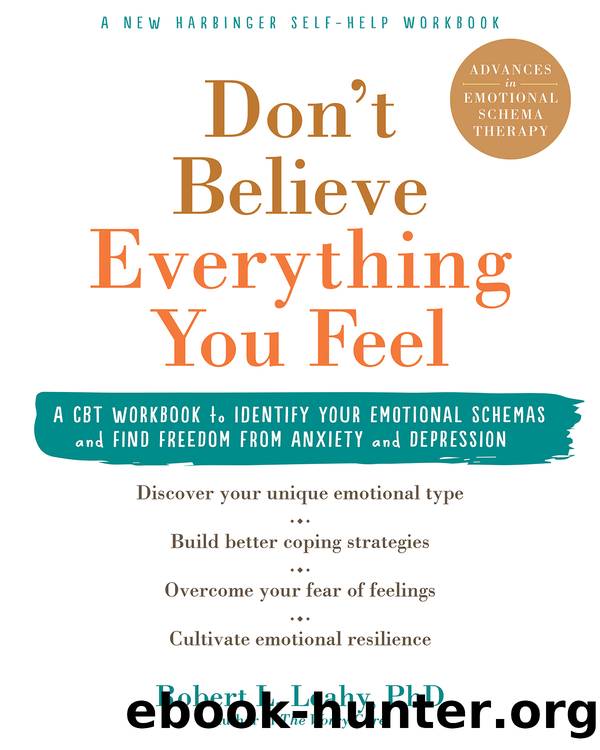Don't Believe Everything You Feel by Robert L. Leahy

Author:Robert L. Leahy
Language: eng
Format: epub
Tags: managing emotions;emotional schema therapy;Robert Leahy;cognitive behavioral therapy;CBT;emotional freedom;negative emotions;emotion regulation;anxiety;depression;anger;over feeling;powerful emotions;acceptance;validation;self-undermining;catastrophizing;hidden emotions;out-of-control emotions;emotional control;values-based living;emotional intelligence;eq;bpd;borderline personality disorder
Publisher: New Harbinger Publications
Published: 2020-06-05T16:40:35+00:00
Our Biased Thinking
Have you noticed that you often jump to conclusions, see things as far worse than they turn out to be, and view many things that happen in terms of the way things “should” be, rather than simply describing and accepting the world as it is? This doesn’t mean that your feelings are not real, it doesn’t mean that you can’t be right about things being bad, and it doesn’t mean that morality and rules don’t count. But it might be that you have habitual patterns of thinking that escalate your emotions and make you prone to anxiety and depression.
A very powerful way of changing our feelings is to think about the situation in a different way. This is the hallmark of cognitive therapy, which was developed by Aaron Beck and Albert Ellis. It’s a form of therapy that has been shown to be effective for depression, anxiety, anger, couples issues, substance abuse, and schizophrenia (Beck et al. 1979; Ellis and Harper 1975; Leahy 2018). Cognitive therapy focuses on your “cognitions,” or thoughts. It proposes that our feelings are often the result of how we think about things. We call these negative thought biases automatic thoughts because they occur spontaneously and seem plausible. People who are depressed believe in the negative triad—a negative view of the self, experience, and future—with thoughts such as “I am a loser,” “This is a terrible experience for me,” and “The future is hopeless.”
People who are prone to anxiety have their “threat detectors” operating on an ongoing basis, scanning their experience for signs of rejection, failure, or danger. Examples of this threat-detection bias include beliefs that other people don’t like us, that we will fail on a task, or that our anxiety will escalate to a panic attack and we’ll go insane or die. And people who are prone to anger tend to view other people as blocking them for getting what they want, humiliating them, provoking them, or insulting them (Beck 1999; DiGiuseppe and Tafrate 2007). Examples include the belief that others are in our way, that they are disrespectful, or that they are treating us with contempt. Couples in conflict tend to have one person believing that their partner should know what they want without them having to tell them, that everything should be going great at all times, and that they shouldn’t have to compromise (Epstein and Baucom 2002).
If you see yourself in any of these patterns, then you are not alone. We all have biases in our thinking. It is human nature. We sometimes think ourselves into the idea that the world is a terrible place or that there is something fundamentally wrong with us. But we can examine these biases, or distortions, in our thinking and see if they really make sense.
Let’s look at some common biases in thinking, starting with you. You can do this by prompting yourself: “I am upset because I am thinking…” You might answer, “… that my boss will criticize me.” And then you
Download
This site does not store any files on its server. We only index and link to content provided by other sites. Please contact the content providers to delete copyright contents if any and email us, we'll remove relevant links or contents immediately.
Should I Stay or Should I Go? by Ramani Durvasula(6923)
Why We Sleep: Unlocking the Power of Sleep and Dreams by Matthew Walker(5762)
Fear by Osho(4161)
Flow by Mihaly Csikszentmihalyi(4135)
Why We Sleep by Matthew Walker(3855)
Rising Strong by Brene Brown(3852)
Too Much and Not the Mood by Durga Chew-Bose(3758)
How to Change Your Mind by Michael Pollan(3744)
The Hacking of the American Mind by Robert H. Lustig(3664)
Lost Connections by Johann Hari(3526)
He's Just Not That Into You by Greg Behrendt & Liz Tuccillo(3378)
Evolve Your Brain by Joe Dispenza(3120)
What If This Were Enough? by Heather Havrilesky(2986)
Resisting Happiness by Matthew Kelly(2943)
Crazy Is My Superpower by A.J. Mendez Brooks(2916)
The Courage to Be Disliked by Ichiro Kishimi & Fumitake Koga(2878)
The Book of Human Emotions by Tiffany Watt Smith(2832)
Descartes' Error by Antonio Damasio(2808)
In Cold Blood by Truman Capote(2752)
